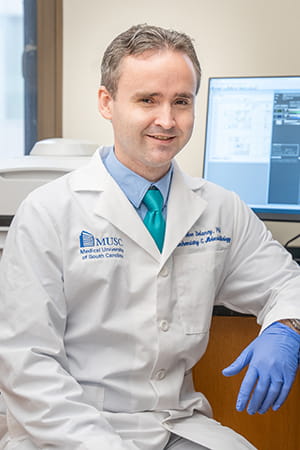Most uterine cancers have excellent five-year survival rates – up to 95% for localized cancer. Serous uterine cancer is an exception, with five-year survival rates of 35% to 50% for stage 1 or 2 cancer.
Now, researchers at MUSC Hollings Cancer Center say that in the course of developing a new model for ovarian cancer, they've developed additional evidence that serous uterine cancer possibly begins in the fallopian tubes, not the uterus. In other words, it's already metastatic by the time that it's found in the uterus.
The paper describing this evidence and the new ovarian cancer model was published this month in Cancer Research Communications.
Senior author Joe Delaney, Ph.D., attributed the finding to the most elemental building block of science: curiosity.

As he and his team worked to develop a sorely needed model of ovarian cancer, they were pleased to see the model working as expected, with cancer signals showing up on the fallopian tubes and ovaries – but taken aback to also see these signals in the uterus.
"We said, 'Hey, wait a minute. I see this signal over in the uterus – specifically on the uterine epithelial cells – which definitely should not have these cancer signals coming from it.' Particularly because this driver is only expressed on the fallopian tube itself, we shouldn't be having expression on these uterine cells," he said.
The team wasn't surprised to see cancer signals on the fallopian tubes because that's where they'd sent the oncogene – a gene that promotes cancer growth. They'd specifically targeted the fallopian tube, instead of the ovary, because most ovarian cancers originate there.
"Ovarian cancer is a misnomer," Delaney explained. "Ovarian cancer, probably about 80% of the time, starts on the fallopian tube, not the ovary."
He had first decided to build an ovarian cancer model for the simple reason that there wasn't one that applied to most ovarian cancer patients.
There are some existing models, Delaney noted. But they were created specifically for ovarian cancers that develop because of mutations on the PTEN or BRCA genes, which account for a minority of all ovarian cancers.
"That leaves you with 75% of patients who don't have an adequate genetic model," he said. These genetic models are instrumental in understanding how cancer develops and in developing and testing new drugs.
That led his team, seven years ago, to begin developing a new ovarian cancer model. Instead of building a model that relies on removing tumor suppressors, they built a model using the MYC oncogene, which helps as much as 70% of all human cancers to grow. The MYC oncogene hadn't previously been used in an ovarian cancer model. For this model, they paired it with a promoter, telling it to go to the fallopian tubes.
The result was cancer in both the ovaries and the uterus.
"But they also clustered with this form of uterine cancer that we did not expect, so the uterine cancer cells look transcriptionally similar to the high-grade serous ovarian cancer cells."Joe Delaney, Ph.D.
The team then began to grow these cancer cell lines in the lab and examine them for similarities to known human cancer. As expected, the ovarian cancers looked like human high-grade serous ovarian cancer.
"But they also clustered with this form of uterine cancer that we did not expect, so the uterine cancer cells look transcriptionally similar to the high-grade serous ovarian cancer cells," he said.
Intrigued, Delaney began to look for previous studies and found real-world examples that matched his observations.
In one study from McMaster University in Canada, pathologists looked at samples from various gynecologic cancers without knowing the specific diagnosis. They found serous tubal intraepithelial carcinoma (STIC), a precancerous lesion, in uterine serous carcinoma and serous ovarian carcinoma but not in nonserous uterine cancer or benign conditions.
"The uterine serous carcinoma had the exact same rate of STIC lesions as high-grade serous ovarian cancer patients," Delaney said.
A retrospective study in Sweden compared the rates of uterine cancer over the course of 37 years between women who had undergone tubal ligation and those who hadn't. Tubal ligation is permanent birth control that surgically ties off the fallopian tubes to prevent eggs from getting to the uterus – but the Swedish study seemed to indicate the procedure had also prevented cancer cells from traveling from the fallopian tube to the uterus because the rates of uterine cancer in the tubal ligation group were lower, particularly for the more aggressive form.
"Those researchers were epidemiologists, so they don't have a lab. They could speculate as to what's happening but they didn't have the ability to test it," Delaney said.
His lab, however, plans to attempt to replicate those findings by removing fallopian tubes from mice and then tracking the rates of serous uterine cancer.
"We'll find out in two years. That's the timeline," he said.
In the meantime, Delaney has already been contacted by other researchers who'd like to use the model. As intended, this new model can be used to study how high-grade serous ovarian cancer develops in women without gene mutations – and how it could be treated.
In addition, it could also potentially be used as a model for uterine serous carcinoma.
"We could have generated the first mouse model to actually mimic this uterine serous carcinoma," Delaney said. "And we might have accidentally created it because it's not a uterine cancer – it's a metastatic form of ovarian cancer, and we've just been calling it uterine cancer this whole time because that's where the tumor develops."
Delaney said the unexpected finding was a thrill.
"I was looking at these slides with my trainees, and I was just as equally excited as they were."
Cancer Research Communications (2024) 4 (9): 2525–2538.
https://doi.org/10.1158/2767-9764.CRC-24-0144






